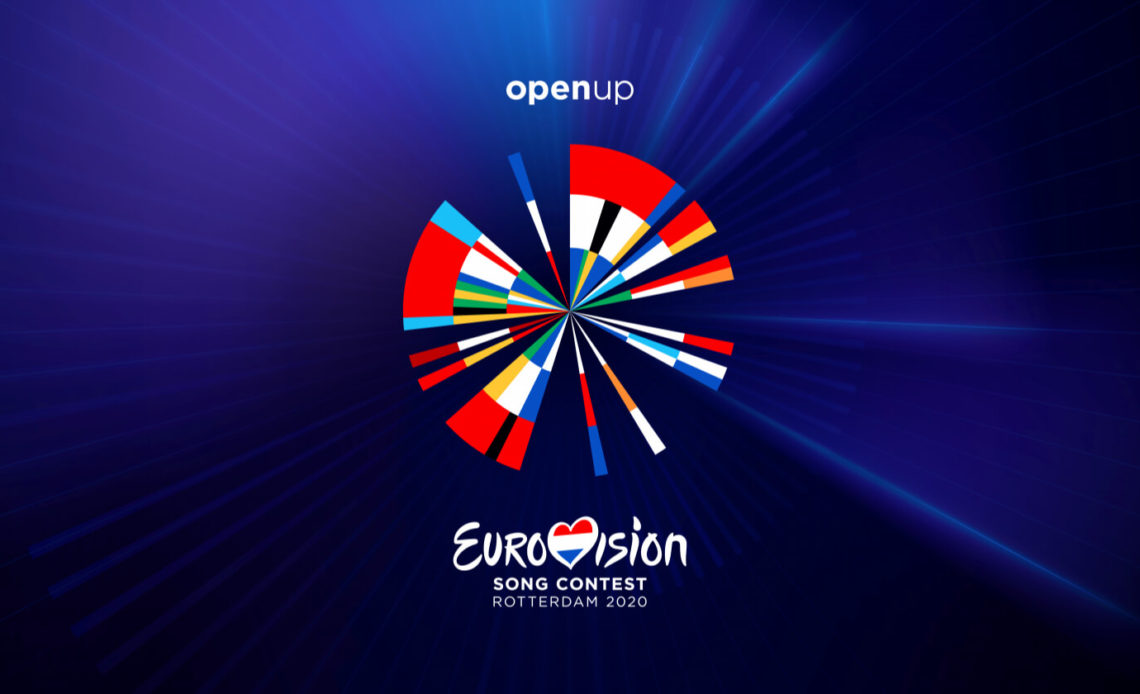
It had never occurred to me to try and host a virtual remote Eurovision party until the worst happened: the 2020 contest was cancelled due to COVID-19 – the first cancellation in the contest’s 65-year history. In the past few years, I’ve hosted a Eurovision viewing party at my flat for the night of the final, so I decided to look into hosting a virtual event to coincide with another momentous occasion – my 30th birthday.
A lot of the preparation was fairly straight-forward: invite a load of friends, assign them a country and ask them to vote for their favourite songs. But one thing was clear to me: the scoreboard was essential. The scoreboard makes Eurovision. I knew I needed something as accurate as possible and -likewise – a scoring system that would reflect the show itself.
More posts on Eurovision here.
The easy part: the guest list and guest participation
As I mentioned, the surprisingly easy part was getting people on board and explaining the concept. I invited a group of friends via Facebook and assigned each ‘household’ a country and encouraged people to get dressed up, create flags and adopt their country persona for the voting announcement. (Terrible accents were encouraged.)
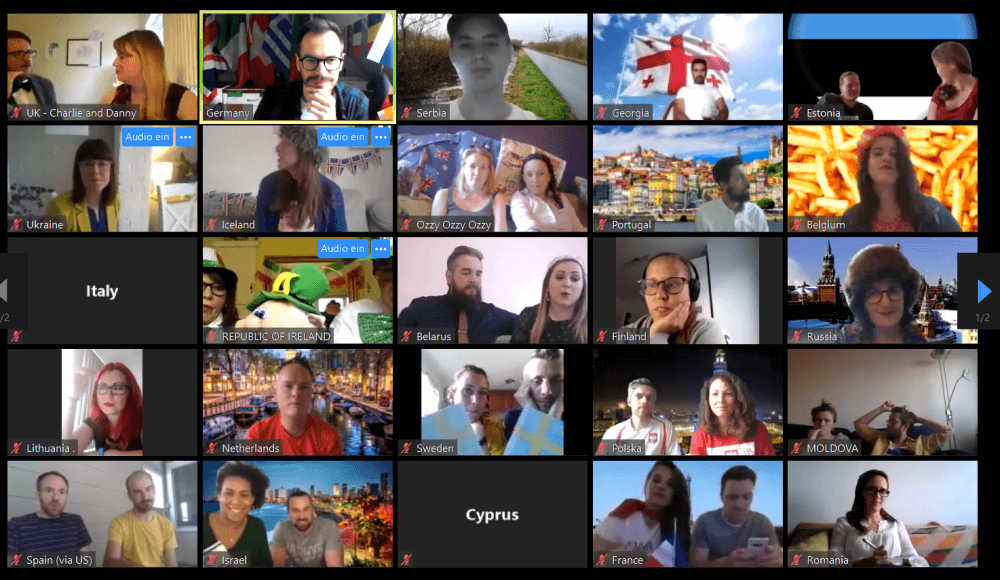
A snapshot of the evening
I’m quite lucky in that my life and work has been quite international, so my guest list ended up being pretty international too. We had people dialling in from 10 different countries, representing 15 nationalities: 30 Brits (including 2 Scots and 7 people from Northern Ireland), 10 Germans, 4 Swedes, 4 Irish, 4 French, 2 Norwegians, 2 Turkish, 2 Americans and 1 person each flying the flag for Armenia, Finland, Chile, Spain, Portugal, Poland and Morocco.
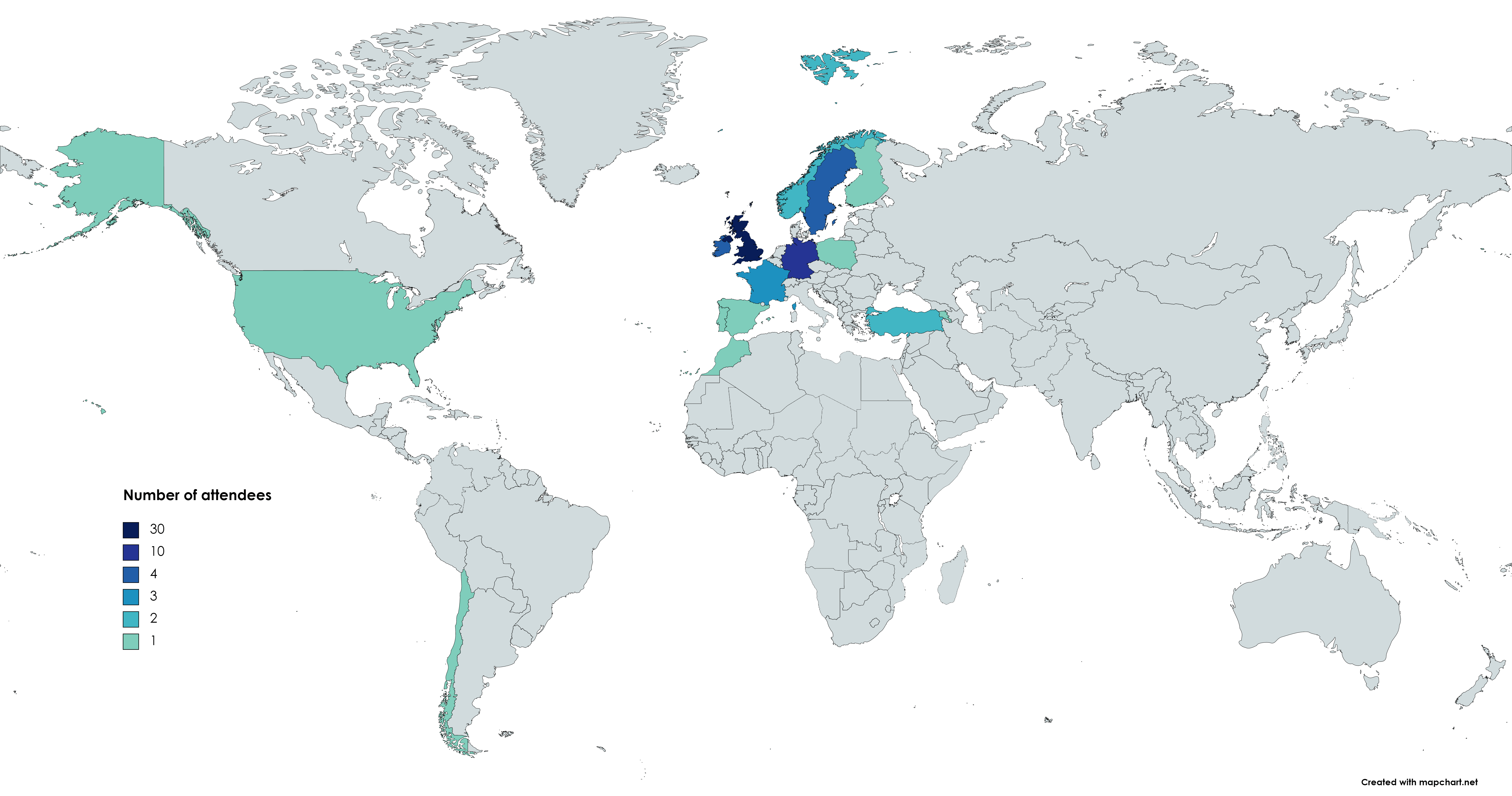
Where the guests for virtual Eurovision 2020 were from
For most people, the participation was limited to just watching “the show” and voting at the end.
However, I asked a select group of people to help me select the finalists. I put together six jurors (including myself), who I knew had different music tastes to me, were from a decent mix of countries (the UK, Ireland, Germany and Armenia) and had varying levels of knowledge about the Eurovision Song Contest. The votes from the six of us made up 50% of the votes for the semi-finals. (More on the other 50% below.)
The fun part: putting together the show
I was striving for maximum authenticity for my virtual Eurovision party, so that meant another important aspect couldn’t be left out: commentating. I knew this was my chance to bore impress friends and family with years’ worth of Eurovision trivia, so I went all out: I even prepared a script. I tried to stick to around one minute per entry to give a brief background of the performer, the country’s history and/or the country’s selection process. For many guests, it was essential education in all things Eurovision. The script was four pages long.

Channeling my inner Graham Norton
As part of the script, I added in three breaks in between songs where I recreated the atmosphere of the green room. I interviewed my guests as their host countries, asking them how they rated their chances and asking what kind of song they were looking out for as their own potential winner. This also went down surprisingly well – it’s always hard to measure people’s appetites for ‘role-play’.
Another fun aspect of hosting a virtual Eurovision was putting together the running order, of which I think Jon Ola Sand would’ve been proud. I entered the finalists into a random online generator to assign them a first and second half (just like the real thing) and then got to work putting them in a running order that I thought would be the most exciting.
I then created my Eurovision Song Contest 2020 Grand Final as a playlist on YouTube. Wherever possible, I favoured live performances over studio versions or official videos and I think we ended up with a good mix.
The best part: the Eurovision scoreboard
The real triumph of my virtual Eurovision party was actually one of the easiest: the scoreboard. The scoreboard is the most iconic part of any Eurovision (both real and virtual) and I wanted to get it exactly right. Luckily for me, someone already had: Scorewiz.eu.
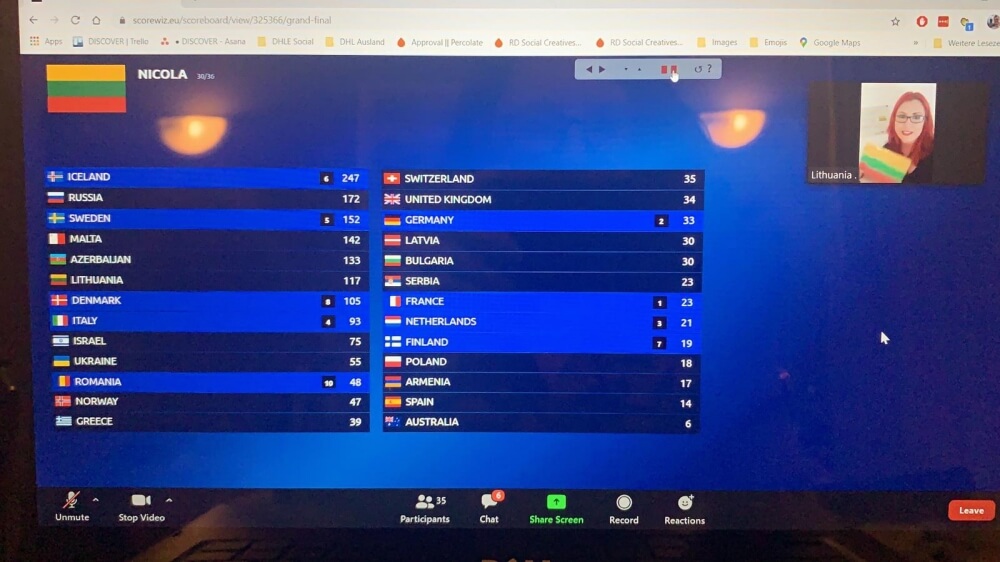
Nicky presenting Lithuania’s scores
I stumbled upon Scorewiz by accident and realised it was exactly what we needed – a fully automated scoreboard that all guests would enter their scores into automatically, without me having to upload everything from an excel sheet (which would have been a genuine nightmare). At some point during the preparation, I had a technical question and reached out to Scorewiz on Facebook and got a reply within around 20 minutes.
I created the Eurovision 2020 Grand Final as a scoreboard and pre-programmed the pre-calculated televote score (more below). I then shared the link with the guests and they were able to enter their scores themselves, reminding them they were forbidden to vote for themselves (something the programme doesn’t disallow). When the scores were announced, I positioned my Zoom speaker window in the top-right hand corner to resemble the real voting.
We did, however, have technical issues with everyone trying to enter the URL at the same time – I would recommend asking guests to open the URL in advance to avoid overloading the server.
Read more: National languages and the rise of English at Eurovision
The tricky part: the scoring
Now, hosting this party was not all smooth sailing. We had the very real issue of how simulate the televote, i.e. 50% of the final score. I wanted the highest degree of accuracy as possible, so I roped in my friend Nicky (who has subsequently become a fellow Eurovision obsessive) who works as a state tax inspector. She created an algorithm that would help us to generate the televote score.
We started by collating sources. We needed sources that would rank all 41 entries (as opposed to just a top 10). However, we didn’t just want to rely on fan rankings (which I suspected would heavily lean to the fan favourites), but also include sources that focused on the quality of the songs, to add a layer of “neutrality.” I also wanted to incorporate rankings which already combined the opinions of multiple people, as opposed to just rankings from YouTubers. That way, we would have the best chance of representing the views of millions.
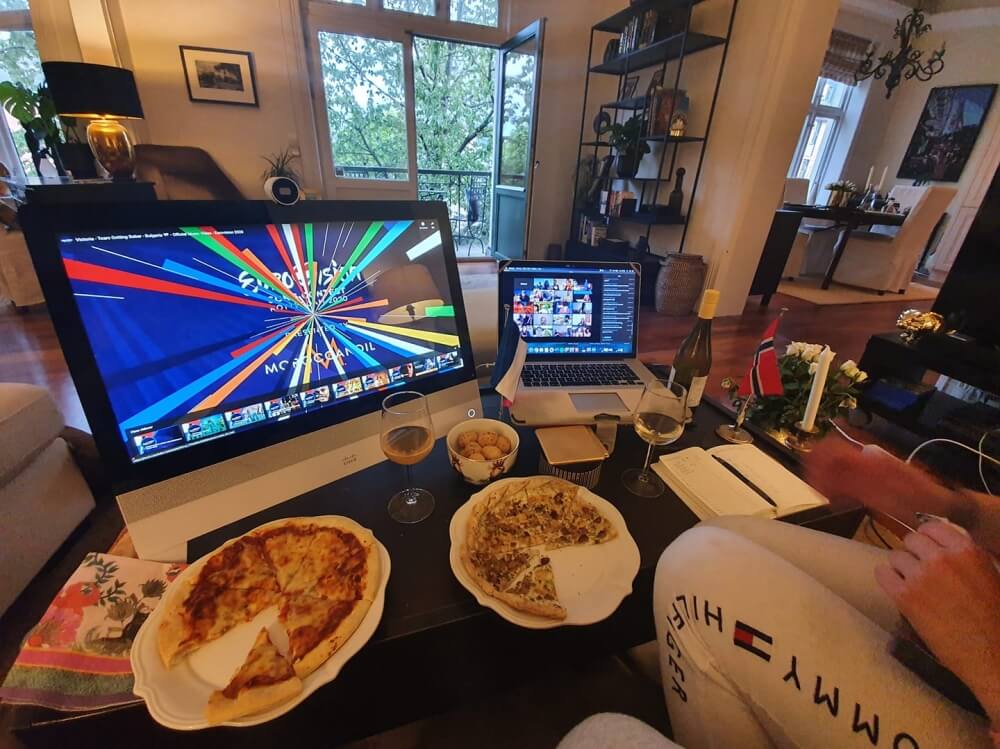
France and Norway pulled out all the stops in while dialling in from Oslo
In the end, we settled on four sources:
- The WIWI Jury
- The betting odds (as listed on Eurovisionworld on the day of cancellation – link to 2021 odds here)
- My Eurovision Scoreboard rankings (related article)
- WIWI Opinion poll (dated 3 April)
Each country was given a score per source, based on where it fell within the ranking. However, this initially led to a very even points distribution, i.e. first place was two points ahead of second place and second place was two points ahead of third place etc. It just wasn’t realistic.
So in order to encourage more variation in the data, I created a scale that points would be awarded on. Instead of 41 points, countries were given a score between 0 and 82, with more variation between the higher end of the rankings (i.e. the top 5 of each ranking received scores between 74-82, while the next 5 were scored between 40-45). The bottom 25 countries in each ranking were awarded points between 0.5-12.5 at intervals of 0.5, to allow for more variation at the top end of the rankings.
The four scores from the four sources were totalled together, giving each country an “Average Rank” Score. (NB: I don’t know why we called it Average when it was a Total Score, but I never said we were professionals…)
Finally, because the total number of points in the televote had to match the total number of points available in the jury vote, Nicky’s (very sophisticated and complicated) algorithm extrapolated the televote points awarded to each country based on the number of countries and its Average Rank Score.
Jury and televote simulation for Eurovision 2020
Long story short; it worked and we had a fairly realistic-seeming televote, awarding points from 11 to the lowest country and 208 to the winner of the televote.
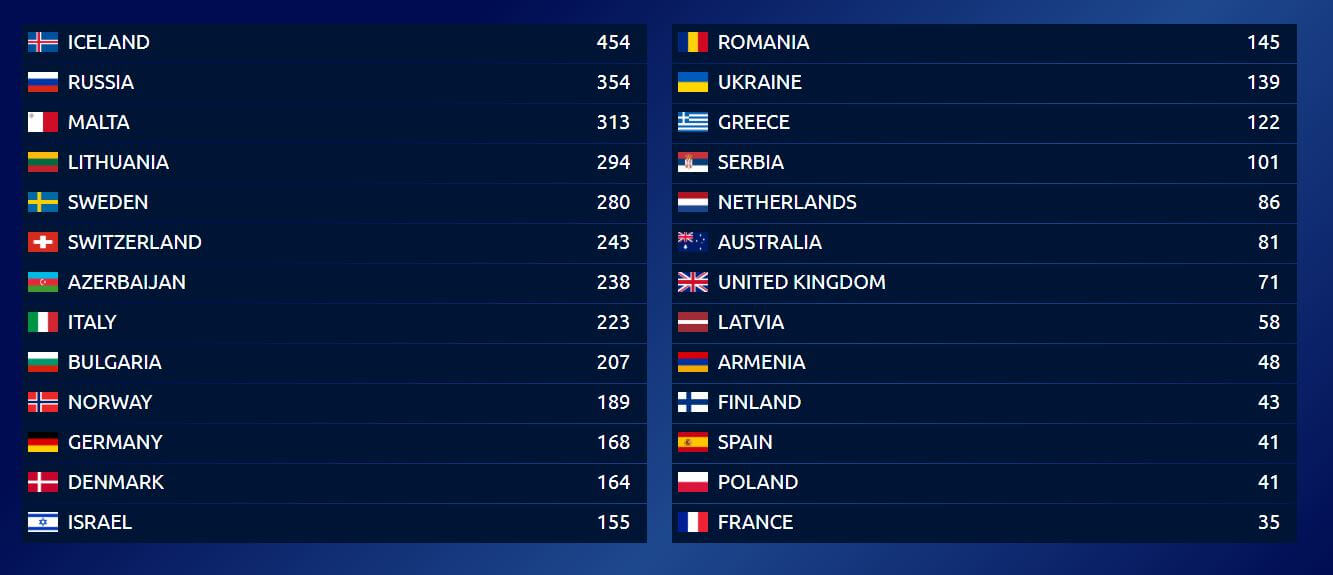
Our final scoreboard
Unsurprisingly, Iceland won our competition, with Russia in second and Malta third. Lithuania and Sweden rounded out the top 5. In the “televote” however, Switzerland came out on top, with Lithuania second, Bulgaria and Iceland in joint third and Russia in fifth place.
You can watch the results here.
The challenges
There were only really two downsides to our virtual Eurovision 2020: the time and the technical issues entering scores.
I was convinced the whole evening was going to take 2.5 hours, max. It took around five and a half hours. I genuinely could not tell you how this happened, but it just took a very long time. Eurovision is not for the faint-hearted. As I mentioned previously, we had a hiccough with the voting, but in the end people were able to submit votes for others using their mobiles or second devices.
The reaction
As you can probably tell, most of those who attended the party were not big Eurovision fans. (Or even small fans, for that matter.) But the outpouring of love and thanks I got after the evening warmed my heart – I have had multiple people tell me it was the best night of lockdown for them by far.
One guest (the very talented Lindsay, representing Russia) even created a handmade Eurovision 2020 trophy and sent it to me in Germany. Plus, every single guest has signed up for virtual Eurovision 2021 (to be held a week before the actual show) – so I must have done something right!
The websites you need to host a virtual Eurovision party
So in summary, here’s what you need to put it all together:
- Facebook / Whatsapp or any app that allows you to create an event. There were a few notices to communicate in the run-up to the event.
- Zoom – the whole party was hosted via zoom. Participants were mostly on mute, but my commentary was provided via Zoom. A pro account is essential. For the voting, we watched the scoreboard on my screen, with the Zoom speaker window functioning as the “country.”
- Watchtogether – I created a room for everyone to stream the YouTube videos together. A few people had some technical issues but could follow along via the YouTube playlist.
- Google sheets – We used approximately one million tabs while working out the correct formulas.
- Random generator – Handy for splitting the countries into first half/second half when creating the running order.
- YouTube – Creating the playlists.
- Scorewiz – the star of the show!
Any questions? Comment below!


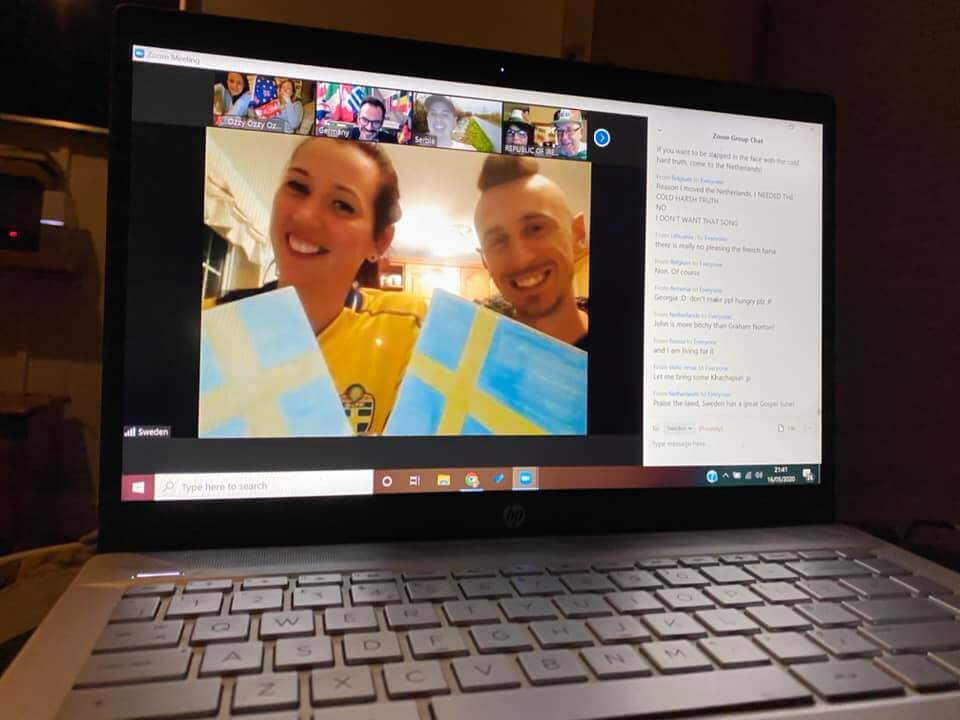
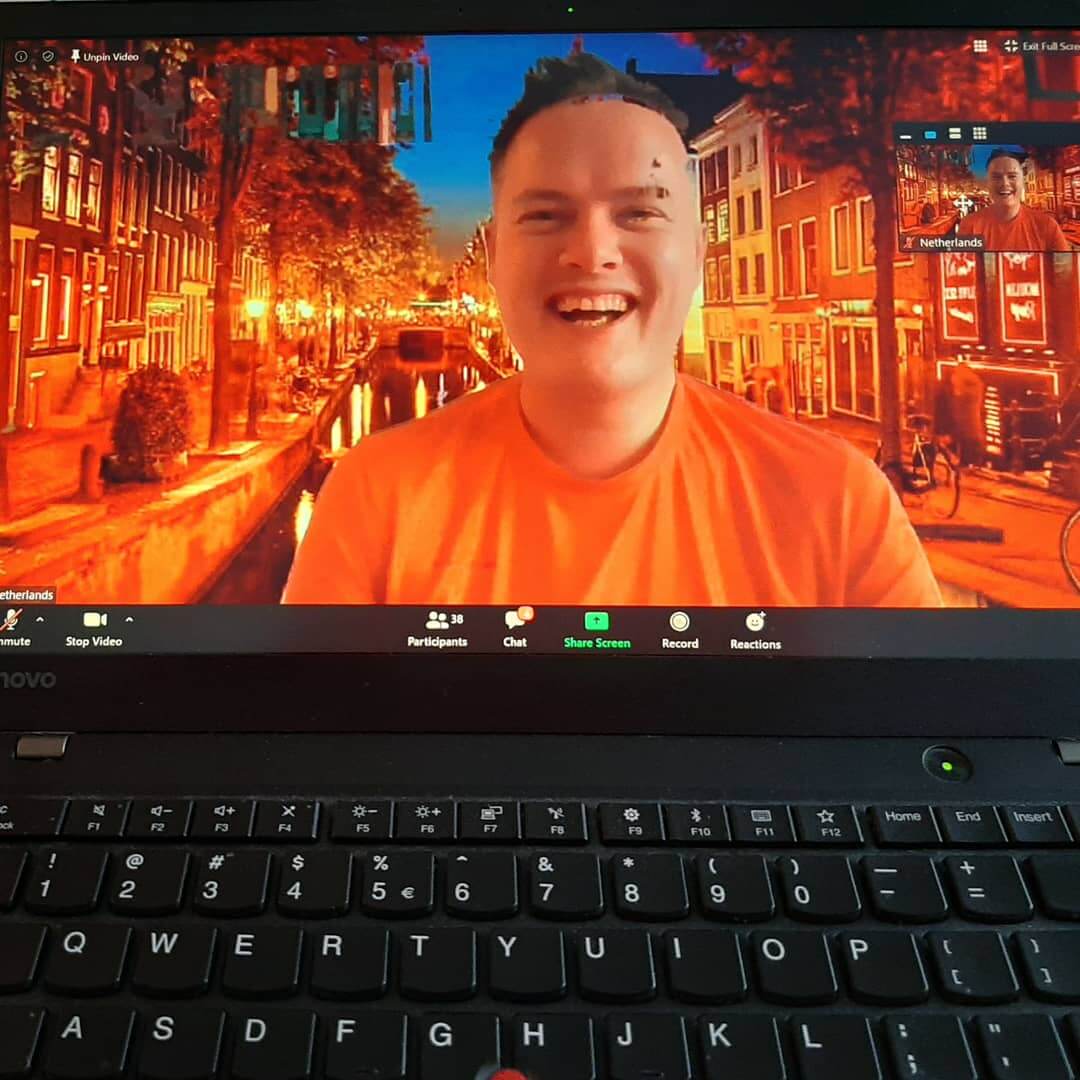




Best Eurovision party ever, can’t wait until this year. It’s marked on the calendar already. Love Slovenia x
We are very excited to have you back! Fingers crossed you’ll make the final this year (SPOILER ALERT: you definitely won’t).
Wow. Thank you, John… I am definitely gonna do this with my besties. LOL, I am not europian I am Sri Lankan. But I just have a fascination with Eurovision………… 🥰
Great to hear the contest is so popular outside of Europe!
What happens when scorewiz does not send you the link
I didn’t have this issue, but I imagine if you message them on Facebook, you’ll get a reply fairly soon? Hope that helps!